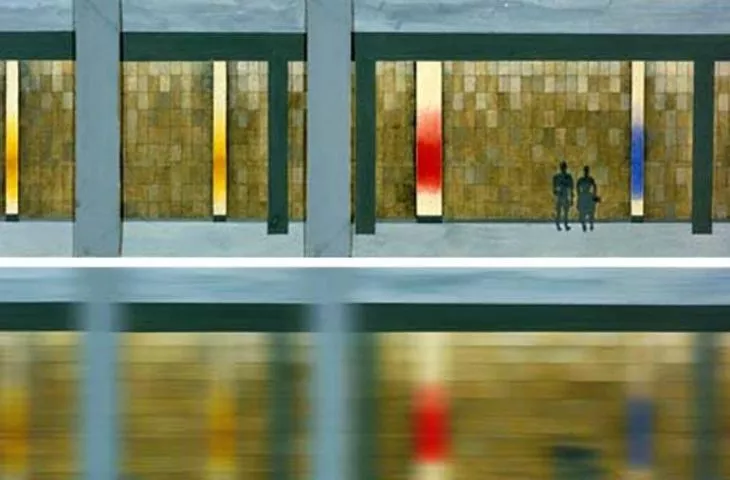The artist Wojciech Fangor needs no introduction. Few people know that he is the author of the mosaics decorating the Warszawa Śródmieście railway station. Abstract compositions of multicolored ceramic tiles have decorated the walls and ceilings of the underground part of the Warszawa Śródmieście railway station for more than 60 years. In December 2020, Wojciech Fangor's mosaics were entered in the register of monuments.
Warsaw Downtown Railway Station project
The Warszawa Śródmieście railroad station in Jerozolimskie Avenue is almost entirely underground. The station was built in the 1950s according to a design by architects Arseniusz Romanowicz and Piotr Szymaniak, who reused the platform hall walls of the Main Station, which was destroyed during the war. From that time come, among others, two Socialist Realist entrance pavilions, erected symmetrically to the axis of the Palace of Culture.
The underground part was already finished in the 1960s, and the designs were created in 1960-1962 at the Artistic and Research Establishments of the Warsaw Academy of Fine Arts, an avant-garde studio operating within the Interior Design Department, under the direction of architects Jerzy Soltan and Zbigniew Ihnatowicz. The team included prominent personalities of Polish architecture, fine arts and design, including painter Wojciech Fangor, draughtsman and sculptor Lech Tomaszewski, interior designer Bogusław Smyrski, authors of artistic ceramics Helena and Lech Grześkiewicz, as well as specialists in acoustics, lighting.
The interior of the Downtown Station for those years was extremely innovative, shocking with spatial and artistic solutions. The platform hall and adjacent rooms were finished with travertine and washed concrete. The pillars supporting the ceiling were covered with artistically perforated sheet metal. Above the platforms, metal ribs were suspended, which not only muffled the noise of the trains, but also diffused the light of the lamps placed above them. In the ticket office halls and waiting rooms, avant-garde lamps in the form of black tubes hung from the ceilings. Characteristic benches with wavy seats were placed on platforms and in waiting rooms. A special typeface of letters was designed for visual information.
Wojciech Fangor's mosaics
photo postwar modernism
Wojciech Fangor's mosaics
An additional decoration of the station are abstract mosaics, whose author was the prominent painter, graphic artist and poster designer Wojciech Fangor. The mosaics were also designed by Stanislaw Kucharski in cooperation with Viola Damiecka and Jolanta Bieguszewska. All of them were arranged from glazed ceramic tiles measuring 4 by 3 cm, made at the Faience Works in Wloclawek, partly using dyes imported from Italy. The artists Helena and Lech Grześkiewicz were responsible for the technological process and the final form of the ceramics.
In December 2020, the Provincial Conservator of Monuments protected 52 ceiling mosaics located above the station's three platforms, as well as 27 wall mosaics located in the halls and rooms of the former waiting rooms adjacent to the side platforms, as well as in the passageways leading to the central platform.
photo by Warszawskie Mozaiki | Instagram
The mosaics are located under the ceiling above the three platforms and on the walls incorporated into the gaps between the stone cladding panels. Compositions of red, orange and yellow tiles accompany travelers waiting for the train in the eastern direction, while blue and green tiles accompany travelers waiting for the train in the western direction.
The above painting experiences of Fangor, in conjunction with research on traffic perception undertaken at the Artistic and Research Establishments, contributed to the innovative idea of integrating the decoration with the space of the train station. The designers intended the mosaics to be a tool of visual impact, both on travelers staying at the station and viewing the wall decorations from the windows of a moving train," wrote Provincial Monument Conservator Prof. Jakub Lewicki in his justification for entering the mosaics in the register of monuments.
Photo: Warszawskie Mozaiki | Instagram
reconstruction of the train station
Cooperation between PKP S.A. and the provincial conservator of monuments has not always been straightforward. The company appealed to the Ministry of Culture against the inclusion of the Warsaw Ochota and Warsaw Powiśle stops from the early 1960s and the remains of the Terespol Station in Praga from the 1860s in the register of monuments. What will it be like this time?
Currently, the Warszawa Śródmieście Station is managed by PKP S.A., but the final concept for its reconstruction in the context of the planned modernization of the suburban cross-city line has not yet been developed. PKP S.A. has no plans to appeal the decision of the Mazovian Regional Monument Conservator to enter the mosaics by Wojciech Fangor in the register of movable monuments. PKP cooperates with conservation services on a daily basis and respects the decisions of monument protection offices," Michal Stilger assured Gazeta Wyborza.

















